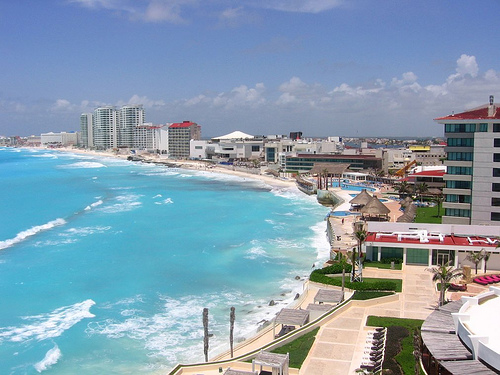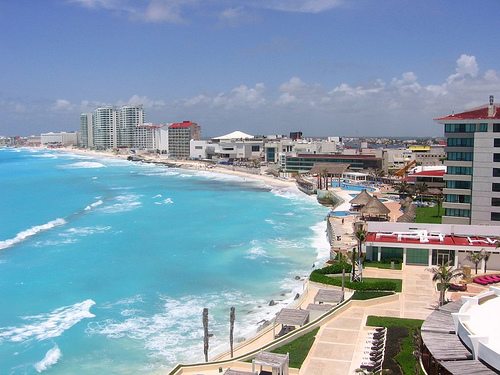 Overall, Cancun was a small but significant success.It’s official, at least according to NASA: worldwide, 2010 was the hottest year on record. The National Oceanic and Atmospheric Administration (NOAA) and the U.K. Met Office Hadley Centre may disagree, but the bottom line, says Andrew Freedman of the Washington Post, “is that all of the data as measured by land, sea, air, and even from space, shows 2010 has been an unusually warm year globally.”
Overall, Cancun was a small but significant success.It’s official, at least according to NASA: worldwide, 2010 was the hottest year on record. The National Oceanic and Atmospheric Administration (NOAA) and the U.K. Met Office Hadley Centre may disagree, but the bottom line, says Andrew Freedman of the Washington Post, “is that all of the data as measured by land, sea, air, and even from space, shows 2010 has been an unusually warm year globally.”
Meanwhile, the international climate talks in Cancún concluded Saturday with an agreement endorsed by 193 of the 194 countries present. For the first time, the international climate agreement included emissions targets for developing as well as developed countries, as well as an adaptation and mitigation fund for channeling $100 billion from developed to developing countries via the World Bank.
Scientists were quick to point out if emissions pledges are delivered upon, they could lead to 5.7 degrees of warming and a CO2 concentration of 650 parts per million (ppm) by 2100. Notably, India indicated it would accept greenhouse gas emissions limits in the future, and the country played a key role in breaking a deadlock over how to verify emissions.
The deal represents a starting point, at least, but, “ongoing greenhouse gas emissions have committed the world to at least [a] 1.5-degree Celsius (2.7 degree Fahrenheit) warming from pre-Industrial levels.” This is a mere 0.5 degree Celsius (0.9 degree Fahrenheit) below what the Copenhagen Accord — and Cancún compromise text — promise to avert.
The agreement also advances a framework for preventing deforestation and transferring green technology to the developing world.
Overall, Cancún was a small but significant success, and international frameworks of its kind aren’t where real progress on climate change is going to be made anyway, says Robert Stavins, director of the Harvard Environmental Economics Program.
Taking the opposite position, John Vidal, environment editor at The Guardian, said most of the “triumphs” of Cancún are merely a “political aspiration,” including the $100 billion for a climate fund.
“For there to be any chance to hold temperatures to even 2C, countries had to agree to ‘peak’ their emissions in the next 10 years and then rapidly reduce them. But all references to peaking have been dropped [from the agreement],” Vidal adds.
A “clear and present danger” to civilization: More than a few reports were timed to coincide with the news spotlight shown on climate issues during the Cancún talks, and bluntest among them is a new paper [PDF] from Ohio State University’s Lonnie Thompson, who is worth quoting in full:
Climatologists, like other scientists, tend to be a stolid group. We are not given to theatrical rantings about falling skies. Most of us are far more comfortable in our laboratories or gathering data in the field than we are giving interviews to journalists or speaking before Congressional committees. Why then are climatologists speaking out about the dangers of global warming? The answer is that virtually all of us are now convinced that global warming poses a clear and present danger to civilization.
Self-described “climate hawk” Joseph Romm has a summary of Thompson’s paper and links to his other work at Climate Progress.
A new study describes the fate of the American southwest in the near future, including a high likelihood for a 60-year drought of the kind last seen in that region during the Middle Ages.
“I don’t consider the Southwest unique,” Peter Gleick, president of the Pacific Institute, told ClimateWire. “I consider them the first dying canary in the coal mine. … There is more and more evidence that climate changes are going to be felt in the Southwest early and deeply.”
When “smart growth” means harvesting energy from cities themselves: A paper that went largely unnoticed by the press when it first came out in late October proposes exploiting the fact water in aquifers below cities is slightly warmer than surrounding areas in order to heat those same cities. Researchers estimate that by exploiting the “urban heat island” effect, they could warm entire cities such as Winnipeg and Tokyo for centuries.
In China, the Hangzhou East Railway Station for high-speed trains will soon sport the world’s largest single-building solar photovoltaic power plant, which will cover 148,000 square meters (1.3 million square feet) and generate 10 megawatts of power.
Stateside, Soladigm, a company that just received $30 million in early-stage funding, hopes to manufacture windows that automatically dim or become more transparent in response to outside temperatures. Their CEO claims use of these windows can reduce expenditure on heating and cooling by 25 percent.
The Climate Post offers a rundown of the week in climate and energy news. It is produced each Thursday by Duke University’s Nicholas Institute for Environmental Policy Solutions.


